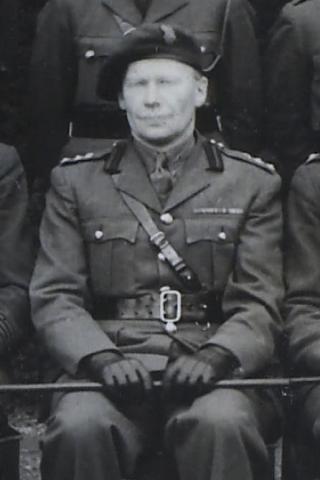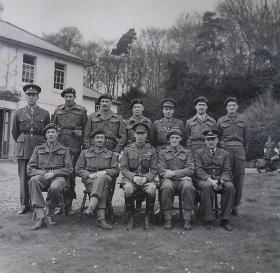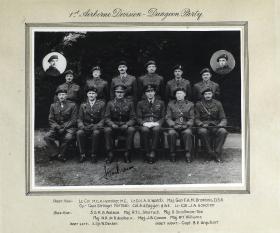Arthur 'Austin' Eagger, a qualified Doctor in civilian life, was one of few Airborne personnel to serve in both the First and Second World Wars.
He was born to Scottish missionary parents in north China in March 1898, and was sent to Robert Gordon’s College in Scotland. He had decided whilst here to try a career in medicine and entered Aberdeen University Medical School, although his studies were curtailed by the Great War. He was commissioned into the Gordon Highlanders in 1917. Despite being wounded in France in 1918, he ended the War as a Company Commander. After the Armistice and demobilisation Austin resumed his medical career and qualified as a Doctor in 1922 and started work as a GP in the West Country.
In 1928 he joined the 128th (Wessex) Field Ambulance RAMC. In 1937 he was in Command of 6th (Southern) General Hospital RAMC (TA). When war broke out in 1939 he appointed as Commander of a convalescent Depot based first at Twelseldown Racecourse, near Aldershot and then at Rouen in France. He was later appointed ADMS of a composite force known as the 'Beauman Division' during the fighting in France in 1940. His skilful coordination of casualty treatment and evacuation during the withdrawal across France via Cherbourg led to him being awarded a CBE.
Shortly after the fall of France, he was appointed as the Senior Medical Officer to the Royal Marines. At this stage of the War in late 1940, Special Service units were being raised, including the first Airborne unit. Soon afterwards, it was decided to form Airborne medical units. Some time in 1941, Austin was appointed as the ’Medical Adviser’ to the Major-General of Airborne and Parachute Troops, Major-General Browning. This post later evolved into the ADMS 1st Airborne Division. As such he was not only responsible in the early days for the recruitment and organisation of the Airborne medical units, but also helped to determine early policies and procedures on the selection, training and equipment of the Airborne forces.
When the 1st British Airborne Corps was formed in 1944 he was promoted to Brigadier and was appointed to Deputy Director of Medical Services (DDMS) for the formation. In September 1944, Browning insisted Brig Eagger accompanied him on Op Market Garden, and was somewhat 'hamstrung' in the area between Nijmegen and Arnhem for several days during the Battle. However, his contribution in planning the evacuation and treatment for the wounded was recognised by the Americans who awarded him the US Bronze Star. This citation paid particular tribute to his tact, energy and foresight in making use of local Dutch facilities. His own efforts were acknowledged to have saved hundreds of lives.
Brigadier Eagger is perhaps more recognisable to today’s generation by being the unnamed senior medical officer from the film ’A Bridge Too Far’ who told Major Brian Urquhart that he was suffering from stress and needed a rest in the days prior to the launch of Operation Market Garden.
Martin Middlebrook, in Arnhem 1944: The Airborne Battle (1994) touched on this subject. Austin Eagger was interviewed for the book and Middlebrook commented;
‘Brain Urquhart was convinced that the Arnhem part of Market was in grave danger, this was based on intelligence reports of two Panzer divisions being in the Arnhem area. He attempted to warn Browning on several occasions but without success. He asked for more aerial photographs to be taken of the wooded areas in which tanks might be sheltering. A Spitfire from a photo-recce squadron obliged, and on the Friday morning (15th September 1944) prints appeared on his desk showing modern Mark III and IV tanks close to Arnhem. Urquhart rushed to General Browning with this new evidence, only to be “treated as a nervous child suffering from a nightmare.”
Browning then acted decisively, but not in the manner Brian Urquhart expected. Brigadier Eagger, Browning’s senior medical officer, was told to send Urquhart on sick leave on account of “nervous strain and exhaustion.” He comments: “I supported Brian Urquhart in trying to prevent this (the Arnhem disaster) but we failed.” Brain Urquhart says: “I always had the impression that he understood better than anyone else on the Airborne Corps staff my own extreme apprehensions about the operation.”’
Middlebrook comments that most of this information came from letters sent to him by Brigadier Eagger. Eagger refused to amplify his statement or to report conversations with Browning, pleading ‘professional confidence’ as he treated both Browning and his wife after the War.
At the end of the War, Austin Eagger served for 16 Airborne Division (TA). He was awarded the Territorial Decoration in 1946, and made Honorary Colonel in 1948.
He resumed his civilian career, and became Director of the Slough Industrial Health Service. One of the first of its kind established in England, the Service is believed to have achieved much to bring about safer and healthier working conditions in firms in that part of the country.
Austin Eagger was also actively involved in the Airborne Medical Society, which he helped to set up as early as 1942, and is still going today. He died in October 1993 aged 95.
Further reading
Martin Middlebrook, Arnhem 1944: The Airborne Battle (1994), Viking: London & New York
With assistance from Niall Cherry
Read More



Latest Comments
There are currently no comments for this content.
Add Comment
In order to add comments you must be registered with ParaData.
If you are currently a ParaData member please login.
If you are not currently a ParaData member but wish to get involved please register.